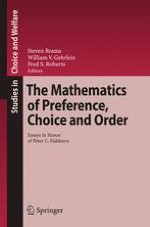
2009 | OriginalPaper | Buchkapitel
Bruhat Orders and the Sequential Selection of Indivisible Items
verfasst von : Brian Hopkins, Michael A. Jones
Erschienen in: The Mathematics of Preference, Choice and Order
Verlag: Springer Berlin Heidelberg
Aktivieren Sie unsere intelligente Suche, um passende Fachinhalte oder Patente zu finden.
Wählen Sie Textabschnitte aus um mit Künstlicher Intelligenz passenden Patente zu finden. powered by
Markieren Sie Textabschnitte, um KI-gestützt weitere passende Inhalte zu finden. powered by
For two players with identical preferences, cake-cutting procedures, such as Cut-and-Choose (Brams & Taylor, 1996) and the Surplus Procedure (Brams, Jones, & Klamler, 2006), guarantee that each player receives exactly half of the cake, according to their preferences. In essence, receiving exactly half is a worst-case scenario because when their preferences are not identical, the opportunity often exists for both players to receive more than half of the cake, measured by their preferences. This potential reward is balanced by risk, as these differences in preferences provide an incentive for players to misrepresent their preferences in an effort to gain a more valuable piece. In contrast, players may not be able to exploit information about an opponent's preferences when indivisible objects are allocated to two players, even when the players ' preferences are different. Our purpose is to determine the structure of, relationship between, and frequency of two players' preferences for which players receive their worst or best possible outcomes when dividing a finite set of indivisible goods, independent of strategic behavior.
Kohler and Chandrasekaharan (1971) pose and solve three optimization problems in which a finite set of players, with linear preference orders over the items, alternate taking turns selecting a number of items from a set of indivisible items. We adopt their framework, as Brams and Straffin (1979) do, to the case when two players alternate selecting a single item from a set of indivisible items. Although Kohler and Chandrasekaharan (1971) assume that players have values associated with each item and subsets are valued according to the sum of the values of its objects, like Brams and Straffin (1979), we assume that the players ' preferences for subsets of items are partially ordered, induced by the linear orders.